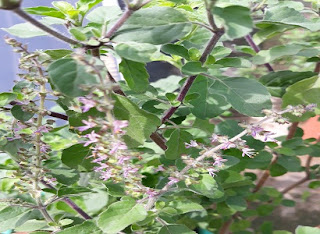Tulsi the holy basil, home remedies
Religiously known as Goddess of Devotion, having a scientific name is Ocimum Sanctum, tulsi is the king of all medicinal plants.
Religiously, traditionally, spiritually tulsi has great value in India and it is widely used in Ayurvedic medicine and home remedies. Tulsi is also used in culinary preparation as it gives a special fragrance to the food. It is common in India to see the tulsi plant in every house. In Hinduism, tulsi is worshipped as Goddess.
It is said that where there is Tulsi, there is health, due to its immense medicinal qualities.
Tulsi has antibacterial, anti-fungal, antiviral, and antioxidant properties. It can be used by children to elders to cure many diseases.
Tulsi grows easily and utmost care should be taken during winter as the leaves will dry out in that season. If tulsi flowers are not removed from time to time the plant will die.
There are more than 20 varieties of tulsi plants are known. The main tulsi varieties used in medicine are called Rama Tulsi and Krishna tulsi. Rama Tulsi has light green coloured leaves whereas Krishna tulsi has purple coloured stem and leaves.
When tulsi is planted around the house it decreases the amount of pollution by producing more amount of oxygen.
Tulsi plants in the garden keep mosquitoes and other insects away due to the fragrance of Tulsi.
Tulsi leaves as well as seeds are also used in home remedies. Beads are made from the dried stem and root of the plant used in making japamalas.
Nowadays tulsi is used in toothpaste, skin ointment, chyawanprash, and other medicinal products.
Tulsi the holy basil, benefits :
Tulsi, clove, salt, and pepper are boiled with water. This water is used for gargling which clears bad smell from the mouth and relieves throat infection. You can also chew tulsi mixed with rock sugar and pepper to get relief from a throat infection.
Juice of 4-5 leaves of tulsi with ginger juice and honey is taken to prevent vomiting sensation.
For migraine, you put 3-4 drops of tulsi juice to your nose. you will relieve yourself from the condition.
For pneumonia and other respiratory condition like asthma, you can prepare decoction using tulsi, ginger, pepper, cardamom with honey and take this morning and evening to get relief.
Boil tulsi juice and sesame oil and use them as ear drops for ear pain.
Ginger, pepper, rock salt, tulsi crushed and taken with food relieves from indigestion, a stomach infection, loss of appetite, and colitis.
Tulsi seeds with rock sugar, if taken morning and evening with milk strengthens the body and improves immunity.
Tulsi can also be used in a face pack mixture with besan flour, curd, and lemon juice removes the dead cells from the skin, and pimples are removed due to their antimicrobial property.
Apply a paste of tulsi and lime juice on skin treats itchy skin due to skin infections.
It brings down fever in case of malaria and dengue fever. For this decoction and tulsi with rock, sugar is used.
It helps to relieve the pain due to arthritis because of its anti-inflammatory property.
Tulsi juice is mixed with pepper and rock salt for gargling relieves from teeth pain.
Tulsi paste is applied to the scalps, it removes lice from the hair and tulsi also strengthens the hair.
If you take Tulsi juice of 4-5 leaves with honey improves memory and relaxes the mind.
Tulsi water is used to wash the wound as it is antimicrobial.
Tulsi, in the Indian tradition :
Tulsi is a sacred plant in Hinduism in India. Tulsi is grown either in front, back, or central countryard of most of the Indian homes. In most of the houses, we can see mantap constructed around the tulsi plant. Everyday people worship tulsi by offering water.
Indian Mythology mentions that tulsi was formed during Amrit Manthan. Tulsi leaves are used to worship Lord Vishnu. Tulsi leaves are part of many religious ceremonies. It is believed that the Tulsi plant ward of evil spirits.
Tulsi cultivation :
Tulsi is grown in farms since its high demand in the market as many Ayurvedic products are using tulsi as one of the main ingredients. Tulsi seeds are sown to get plants having a height of 5-6 inches. Then those plants are planted in the farms.
Organic fertilizer is preferred over chemical fertilizer. Plants are watered well depending on the season. Plants are harvested after the plants start flowering.




Please do not enter any spam link in the comment box ConversionConversion EmoticonEmoticon